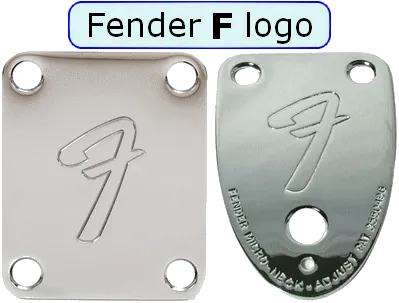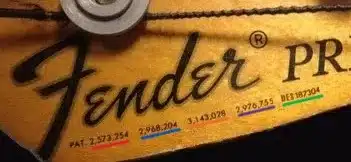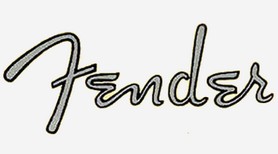How To Find Fender Serial Number?
You can find the Fender serial number at the top of the neck plate, on the front or back of the headstock, on the vibrato cover plate (for Stratocaster), or at the end of the neck heel.
We’ve compiled an extensive Fender serial number database for dating and telling the history of your guitar or bass. We independently collected all data from various sources. The information is quite accurate, though some serial numbers can repeat, others have been lost over time, which led to gaps in our database.
Table of Contents
Fender Serial Number Decoder
(updated version 2024)
To find information about your serial number, just input it into the decoder below, and click the “Check” button. You’ll get all the details about your guitar: the country, production date, and even the factory where your Fender was made. Whether you’re verifying an old Stratocaster or vintage Tele, Jaguar, P-Bass, or any other Fender model, the decoder uncovers all the info you need.
The unique feature of this decoder is that if there are any data overlaps, you will see all possible options for the origin and dating of your Fender guitar or bass.
If you can’t find all the information you need, scroll down and try to look it up in the serial number database by hand.
For extended search you can also
Dating Fender By Serial Number
Although a serial number is useful for roughly determining the age of a guitar, this is often not the exact production date. As a result of the overlap between years, Fender serials are also not by definition chronological.
In the past (before 1976) the serial numbers were often randomly assigned. Most specifications for a particular Fender have hardly changed, if at all. Although there have been times when major changes have taken place, such as the acquisition of Fender by CBS, and the transition from CBS Fender to the current owner, Fender Musical Instruments Corporation, most models have generally not changed.
USA Serial Number 1950-1963
In the early 1950s, the serial number of the Fender Stratocaster was imprinted on the back of the tremolo cover plate. For some Fender Telecaster guitars, the serial numbers were placed on the bridge, nestled between the pickup and the saddles.
Fender’s manufacturing process in the early 1950s sometimes resulted in inconsistent serial numbers. You can also often encounter duplication and reuse of the serial number.
For Fenders made before 1955, the serial number cannot determine the exact date of manufacture. Initially, the Telecaster and Stratocaster models appeared to use different numbering systems, with the ’52 Telecaster possibly having a higher serial number than the ’53 model.
The only way to find out the production date is to remove the neck from the guitar’s body. If the year isn’t clear, it can also be written on the body under the pickguard or within the pickup cavity.
Serial numbers on Fenders made after 1955 follow a more consistent and logical sequence.
The database below shows the serial numbers as they were used from 1950 to 1963.
US Serial Number Database 1950-1963.
| Serial No | Production Year |
|---|---|
| Until 6000 | 1950 – 1954 |
| Until 10000 | 1954 – 1956 |
| 10000 | 1955 – 1956 |
| 10000 – 20000 | 1957 |
| 20000 – 30000 | 1958 |
| 30000 – 40000 | 1959 |
| 40000 – 50000 | 1960 |
| 50000 – 70000 | 1961 |
| 60000 – 90000 | 1962 |
| 80000 – 90000 | 1963 |
| 90000 – L10000 | 1963 |
Telecaster Serial Number 1950-1954
For the Fender Telecaster, Esquire, and Broadcaster models, serial numbers were located on the bridge plate until early 1954. Fender then switched to serial numbering on the heel plate for all models that year.
Esquire, Broadcaster, Telecaster Serial Number Chart (1950-1954).
| Serial Number | Production Year |
|---|---|
| 0001 – 0999 | 1950 – 1952 |
| 1000 – 5300 | 1952 – 1954 |
Precision Bass Serial Number 1951-1955
The Precision Bass experienced some overlapping of serial numbers and dates. Until 1955, the serial number was stamped on the bridge plate. Even though Fender switched to placing serial numbers on the headstock for all models in 1954, they continued to stamp them on the bridge plate for some Precisions.
P-bass serial number Chart (1951-1955).
| Serial No | Production Year |
|---|---|
| 100 – 400 | 1951 – 1952 |
| 0001 – 0999 | 1952 – 1954 |
| 1000 – 2000 | 1953 – 1955 |
US Serial Number 1963-1976
In January 1965, Fender was bought by CBS Corporation. This acquisition didn’t directly affect the serial numbers. CBS kept making guitars using the existing parts and serial numbering system.
The serial number can roughly show the construction date.
- The letter “L” followed by the 6-digit serial number on the Fender neck plate indicates an instrument from the early 60s.
- The large Fender logo “F” says that the Fender was made after the acquisition by CBS, meaning from the mid to late 1960s.

The following database outlines Fender serial numbers from 1963 to 1976. The serial numbers are in chronological order, but due to Fender’s numbering practices, many serial numbers and years overlap.
US Serial Number Database 1963-1976.
| Serial Number | Production Year |
|---|---|
| L00001 – L19999 (Neck Plate) | 1963 |
| L20000 – L58999 (NP) | 1964 |
| L59000 – L99999 (NP) | 1965 |
| 100000 – 109999 | 1965 |
| 110000 – 199999 | 1966 |
| 200000 – 209999 | 1967 |
| 210000 – 249999 | 1968 |
| 250000 – 279999 | 1969 |
| 280000 – 299999 | 1970 |
| 300000 – 339999 | 1971 |
| 340000 – 369999 | 1972 |
| 370000 – 499999 | 1973 |
| 500000 – 519999 | 1973 – 1974 |
| 520000 – 579999 | 1974 |
| 580000 – 689999 | 1975 |
| 690000 – 750000 | 1976 |
Fender Neck Date (before 1976)
For guitars made before 1976, it’s recommended to check the production date or serial number on the neck’s heel. Typically, a production date is stamped or written at the end of the heel. To read this, you’ll need to remove the neck from the body.
Up until about April 1962, the dates on the neck heel were handwritten, after which Fender switched to stamped dates. Both the handwritten and the stamped dates were usually coded.
This code, appearing before the date, is a number from 1 to 28, indicating the model for which the neck was manufactured. Contrary to some beliefs, this number does not represent the day of the month.

Fender Patent Numbers (1960-1976)
Between 1960 and 1977, various patent numbers were added to Fender models. They were stamped in the headstock under the Fender logo.

For example:
PAT, 2,573,254 2,968,204 3,143,028 2,976,755 DES 187304
2,573,254 for pickup and bridge combination.
2,968,204 for the single coil pickup patent awarded in 1961 under others for Fender Jaguar, Stratocaster, and Duosonic.
3,143,028 the patent granted in August 1964 for Fender’s adjustable neck construction.
2,976,755 for the split coil pickup design (used since 1957 for the Precision Bass).
The DES is the serial number.
US Serial Number 1976-1981
The following database shows the most common Fender serials from 1976 to 1981. Note the addition of a letter prefix to the serial number. The “S” prefix indicates the 1970s, a method CBS used in an attempt to clearly mark serial numbers by production year. However, there were still many overlaps, making precise dating based on the serial number sometimes unclear.
USA Serial Number Database 1976-1981.
| Serial Number | Production Year |
|---|---|
| 76 + 5 digits S6 + 5 digits | 1976 |
| S7 + 5 digits S8 + 5 digits | 1977 |
| S7 + 5 digits S8 + 5 digits S9 + 5 digits | 1978 |
| S9 + 5 digits E0 + 5 digits | 1979 |
| S9 + 5 digits E0 + 5 digits E1 + 5 digits | 1980 |
| S9 + 5 digits E0 + 5 digits E1 + 5 digits | 1981 |
US Serial Number 1982-1989
In 1982, the Fender American Vintage Series was introduced, using “V” as the serial number prefix. For guitars from the American Vintage Series, it’s best to check the neck’s date for a specific year.
The “E” prefix, representing the 1980s, was first introduced in 1979.
USA Serial Number Database 1982-1984.
| Serial Number | Production Year |
|---|---|
| E1 + 5 digits E2 + 5 d. E3 + 5 d. V + 4, 5, or 6 d. (American Vintage Series excluded ’52 Telecaster) | 1982 |
| E1 + 5 d. E2 + 5 d. E3 + 5 d. V + 4, 5, or 6 d. (US Vintage excluded ’52 Tele) | 1983 |
| E3 + 5 d. E4 + 5 d. V + 4, 5, or 6 d. (US Vintage excl. ’52 Tele) | 1984 |
In March 1985, CBS Corporation sold Fender to a group of private investors led by William Schultz. After the sale, the company was renamed Fender Musical Instruments Corporation. Despite the change in ownership, the serial numbering system remained the same.
US Fender Serial Number Database 1985-1989.
| Serial Number | Production Year |
|---|---|
| E3 + 5 digits E4 + 5 d. V + 4, 5, or 6 d. (American Vintage Series except for ’52 Telecaster) | 1985 |
| V + 4, 5, or 6 d. (US Vintage*) | 1986 |
| E4 + 5 d. V + 4, 5, or 6 d. (US Vintage*) | 1987 |
| E4 + 5 d. E8 + 5 d. V + 4, 5, or 6 d. (US Vintage*) | 1988 |
| E8 + 5 d. E9 + 5 d. V + 5 or 6 d. (US Vintage*) | 1989 |
To accurately identify the production date of a Fender Stratocaster with a “V” serial number from the American Vintage series, you need to unscrew the neck from the body. The production date is stamped or written on the end of the heel.
US Serial Number 1990-1999
In 1990, Fender introduced the “N” prefix for serial numbers to denote the 90s. The serial number stickers were produced well in advance, leading to an issue where N9 stickers, intended for use in 1999, were mistakenly applied to some instruments made in 1990. Therefore, it’s possible to find guitars from 1990 with an N9 serial number.
For instruments made in 1990, the serial number is located on the front of the headstock. In 1996, Fender shifted the placement of serial numbers to the back of the headstock.
US Serial Number Database 1990-1999.
| SERIAL NUMBER | PRODUCTION YEAR |
|---|---|
| N9 + 5 numerals N0 + 5 nums V + 5 or 6 nums (American Vintage Series except ’52 Telecaster) | 1990 |
| N1 + 5 or 6 nums V + 5 or 6 nums (American Vintage*) | 1991 |
| N1 + 5 or 6 nums N2 + 5 or 6 nums V + 5 or 6 nums (US Vintage*) | 1992 |
| N3 + 5 or 6 nums V + 5 or 6 nums (US Vintage*) | 1993 |
| V + 5 or 6 nums (US Vintage*) | 1994 |
| N4 + 5 or 6 nums N5 + 5 or 6 nums V + 5 or 6 nums (US Vintage*) | 1995 |
| N6 + 5 or 6 nums V + 5 or 6 nums (American Vintage*) | 1996 |
| N6 + 6 or 6 nums N7 + 5 or 6 nums V + 5 or 6 nums (American Vintage*) | 1997 |
| N8 + 5 or 6 nums V + 5 or 6 nums (American Vintage) | 1998 |
| N9 + 5 or 6 nums V + 5 or 6 nums (US Vintage*) | 1999 |
US Serial Number 2000-2009
Starting in 2000, the “Z” symbol was used to represent the 2000s. The Z0 prefix indicates the year 2000, Z1 – 2001, and so on.
The American Deluxe Series follows the same pattern but adds the symbol “D” before “Z”, such as DZ1 for 2001, DZ2 for 2002, etc. However, there are still instances of overlap between serial numbers and production years.
US Serial Number Database 2000-2010.
| SERIAL NUMBER | PRODUCTION YEAR |
|---|---|
| N9 + 5 or 6 symbols Z0 + 5 or 6 symbols DZ0 + 5 or 6 symbols (American Deluxe Series) V + 5 or 6 symbols (US Vintage excluded ’52 Telecaster) | 2000 |
| Z0 + 5 or 6 symbols Z1 + 5 or 6 symbols DZ1 + 5 or 6 symbols (American Deluxe) V + 5 or 6 symbols (American Vintage*) | 2001 |
| Z1 + 5 or 6 symbols Z2 + 5 or 6 symbols DZ2 + 5 or 6 symbols (US Deluxe) V + 5 or 6 symbols (American Vintage*) | 2002 |
| Z2 + 5 or 6 symbols Z3 + 5 or 6 symbols DZ3 + 5 or 6 symbols (American Deluxe) V + 5 or 6 symbols (US Vintage*) | 2003 |
| Z3 + 5 or 6 symbols Z4 + 5 or 6 symbols DZ4 + 5 or 6 symbols (US Deluxe) V + 5 or 6 symbols (American Vintage*) XN4 + 4 symbols | 2004 |
| Z4 + 5 or 6 symbols Z5 + 5 or 6 symbols DZ5 + 5 or 6 symbols (American Deluxe) V + 5 or 6 symbols (American Vintage*) XN5 + 4 symbols | 2005 |
| Z5+ 5 or 6 symbols Z6 + 5 or 6 symbols DZ6 + 5 or 6 symbols (American Deluxe) V + 5 or 6 symbols (American Vintage*) XN6 + 4 symbols | 2006 |
| Z6 + 5 or 6 symbols Z7 + 5 or 6 symbols DZ7 + 5 or 6 symbols (American Deluxe) V + 5 or 6 symbols (American Vintage*) XN7 + 4 symbolsUS + 8 symbols | 2007 |
| Z7 + 5 or 6 symbols Z8 + 5 or 6 symbols DZ8 + 5 or 6 symbols (American Deluxe) V + 5 or 6 symbols (American Vintage*) XN8 + 4 symbolsUS + 8 symbols | 2008 |
| Z8 + 5 or 6 symbols Z9 + 5 or 6 symbols DZ9 + 5 or 6 symbols (American Deluxe) V + 5 or 6 symbols (American Vintage*) XN9 + 4 symbolsUS + 8 symbols | 2009 |
US Serial Number 2010-2024
At the end of 2009, a new 9-digit Fender serial number format was introduced. This format is prefixed with the number “10” (which stands for the second decade of 2000) followed by 7 numerals.
In March 2010, this format was replaced by a new 8-digit format. The two-letter prefix indicates the production location. The first 2 digits after the letters represent the production year. The remaining digits are random and do not provide additional information.
For example: US16340487. The guitar was manufactured in the USA, in 2016.
US Serial Number Database Since 2010.
| SERIAL NUMBER | PRODUCTION YEAR |
|---|---|
| 10 + 7 symbols (Vintage Series except for ’52 Tele, which uses a five-digit number) | End 2009 – March 2010 |
| US + 8 symbols (Vintage Series except for ’52 Tele, which uses a five-digit number) The first two symbols of the number identify the year of manufacture. | Since March 2010 |
Japanese Serial Number
Fender guitars produced in Japan have their serial numbers located on the back of the neck, near where they attach to the body. For some reissue models, the serial number may be found on the headstock or heel plate.
The phrase “Made in Japan” combined with the serial number was utilized up until 1997.
In March 1982, Fender expanded its production by partnering with the Japanese company Fuji Gen Gakki to manufacture instruments.
The serial numbers for “Made In Japan” (MIJ) guitars begin with a letter or a set of letters that denote the year of manufacture. Similar to the system used for U.S. Fender serial numbers. However, these MIJ serials are considered less reliable.
Due to inaccuracies in how this letter system was implemented, the exact dating of MIJ guitars often remains uncertain.
In 1997, Fender switched from using the “Made in Japan” label to “Crafted in Japan” on their guitars. There are instances where “CIJ” (Crafted in Japan) models overlap with the earlier “MIJ” ones. Therefore, it is important to note whether the instrument is labeled “Made in Japan” or “Crafted in Japan”.

“Made in Japan” serial number Chart.
| SERIAL NUMBER | PRODUCTION YEAR |
|---|---|
| JV + 5 digits | 1982 – 1984 |
| SQ + 5 d. | 1983 – 1984 |
| E + 6 d. | 1984 – 1987 |
| A + 6 d. B + 6 d. C + 6 d. | 1985 – 1986 |
| F + 6 d. | 1986 – 1987 |
| G + 6 d. | 1987 – 1988 |
| H + 6 d. | 1988 – 1989 |
| I + 6 d. J + 6 d. | 1989 – 1990 |
| K + 6 d. | 1990 – 1991 |
| L + 6 d. | 1991 – 1992 |
| M + 6 d. | 1992 – 1993 |
| N + 6 d. O + 6 d. P + 6 d. Q + 6 d. | 1993 – 1994 |
| S + 6 d. T + 6 d. | 1994 – 1995 |
| U + 6 d. N + 5 d. | 1995 – 1996 |
| V + 6 d. | 1996 – 1997 |
“CRAFTED IN JAPAN” Serial Number Chart.
| SERIAL NUMBER | PRODUCTION YEAR |
|---|---|
| A + 6 digits | 1997 – 1998 |
| O + 6 d. | 1997 – 2000 |
| P + 6 d. | 1999 – 2002 |
| Q + 6 d. | 2002 – 2004 |
| R + 6 d. | 2004 – 2005 |
| S + 6 d. | 2006 – 2008 |
| T + 6 d. | 2007 – 2008 |
After 2007, the labeling changed again to “Made in Japan”. However, both stickers were used for several years. The serial numbers have been preserved from this cover in the same way as in the “CIJ” system.
Mexican Serial Number
In the late 1980s, Fender established a factory in Ensenada, Mexico, and began producing instruments there in 1990. The serial numbers for “Made in Mexico” (MIM) Fenders, starting with the letter “M,” are located on the headstock of the guitar.
There are some exceptions, such as special editions, signature models, and the American/Mexican-made California series, which have serial numbers beginning with “AMXN.”
The serial numbering system for MIM Fenders is quite simple. For guitars made in the 1990s, the serial number starts with “MN,” followed by a number that specifies the year within the decade. The letter “M” stands for Mexico, and the “N” signifies the 90s.
For instruments produced in the 2000s, the system remains similar, but the serial numbers begin with “MZ”. The prefix “Z” represents the 2000s decade. For the 2010s, the prefix used is “MX1.”
mx serial number chart.
| SERIAL NUMBER | PRODUCTION YEAR |
|---|---|
| MN0 + 5 or 6 numbers | 1990 |
| MN1 + 5 or 6 n. | 1991 |
| MN2 + 5 or 6 n. | 1992 |
| MN3 + 5 or 6 n. | 1993 |
| MN4 + 5 or 6 n. | 1994 |
| MN5 + 5 or 6 n. | 1995 |
| MN6 + 5 or 6 n. | 1996 |
| MN7 + 5 or 6 n. | 1997 |
| MN8 + 5 or 6 n. | 1998 |
| MN9 + 5 or 6 n. | 1999 |
| MZ0 + 5 or 6 n. | 2000 |
| MZ1 + 5 or 6 n. | 2001 |
| MZ2 + 5 or 6 n. | 2002 |
| MZ3 + 5 or 6 n. | 2003 |
| MZ4 + 5 or 6 n. | 2004 |
| MZ5 + 5 or 6 n. | 2005 |
| MZ6 + 5 or 6 n. | 2006 |
| MZ7 + 5 or 6 n. | 2007 |
| MZ8 + 5 or 6 n. | 2008 |
| MZ9 + 5 or 6 n. | 2009 |
| MX10 + 6 n. | 2010 |
| MX11 + 6 n. | 2011 |
| MX12 + 6 n. | 2012 |
| MX13 + 6 n. | 2013 |
| MX14 + 6 n. | 2014 |
| MX15 + 6 n. | 2015 |
| MX16 + 6 n. | 2016 |
| MX17 + 6 n. | 2017 |
| MX18 + 6 n. | 2018 |
| MX19 + 6 n. | 2019 |
| MX20 + 6 n. | 2020 |
| MX21 + 6 n. | 2021 |
| MX22 + 6 n. | 2022 |
| MX23 + 6 n. | 2023 |
| MX24 + 6 n. | 2024 |
Korean Serial Number
Details on Korean Fender serial numbers from 1988 to 1992 are scarce. Serials from this period may or may not have letter prefixes. Additionally, serial numbers were used randomly during this period, making accurate dating tricky.
There’s also not a lot of information about Fender serials from 1993 to 1998. Some of them begin with the letters “CN” or “CV.”
From 1997 onwards, serial numbers have the prefix “KC” followed by 8 numerals. The first 2 digits show the production year. The prefix “KC” signifies the Korean Cor-Tek Factory.
Korean serial number chart.
| SERIAL NUMBER | PRODUCTION YEAR |
|---|---|
| 6, 7 or 8 digits | 1988-1996 |
| CN0 + 5 d. VN0 + 5 d. | 1990-1991 |
| CN1 + 5 d. VN1 + 5 d. CN2 + 5 d. | 1991-1992 |
| VN2 + 5 d. CN3 + 5 d. | 1992-1993 |
| CN1 + 5 d. VN3 + 5 d. CN4 + 5 d. | 1993-1994 |
| VN4 + 5 d. CN5 + 5 d. | 1994-1995 |
| CN1 + 5 d. VN5 + 5 d. CN6 + 5 d. | 1995-1996 |
| VN6 + 5 d. | 1996-1997 |
| KC97 + 6, 7 or 8 d. | 1997-1998 |
| KC98 + 6 d. | 1998-1999 |
| KC99 + 6 d. | 1999-2000 |
| KC00 + 6 d. | 2000-2001 |
| KC01 + 6 d. | 2000-2001 |
| KC02 + 6 d. | 2001-2003 |
| KC03 + 6 d. | 2003-2004 |
| KC04 + 6 d. | 2004-2005 |
| KC05 + 6 d. | 2005-2006 |
| KC06 + 6 d. | 2006-2007 |
| KC07 + 6 d. | 2007-2008 |
| KC08 + 6 d. | 2008-2009 |
| KC09 + 6 d. | 2009-2010 |
| KC10 + 6 d. | 2010-2011 |
| KC11 + 6 d. | 2011-2012 |
| KC12 + 6 d. | 2012-2013 |
| KC13 + 6 d. | 2013-2014 |
| KC14 + 6 d. | 2014-2015 |
Irregular Serial Numbers
The following serial numbers are a bit outside of Fender’s standard numbering. If you are unsure about an unusual serial number, refer to the table below for possible letter and number matches.
| Serial Number | DESCRIPTION |
|---|---|
| AMXN + 6 numerals | California Series electric guitars and basses, ’97 and ’98 (Made in USA and Mexico). |
| DN + 6 n. | American Deluxe series instruments, ’98 and ’99. |
| NC + 6 n. | Squier Strat Bullets. |
| FN + 6 n. | US-made guitars and basses destined for export. Some are not exported or sent back. |
| I + 7 n. | A limited number of these I-Series were made in ’89 and ’90. Made for the export market and have ‘Made in USA’ stamped on the heel. |
| LE + 6 n. | Blonde Jazzmasters and Jaguars that were made in 1994. Sold as a promotional 3-piece set with a Blonde Deluxe Reverb Amp. |
| CN + 6 n. VN + 6 n. | Produced in Korea, Fender/Squier (dating unclear). |
| CA + 5 n. | Gold Strat 1981, ’82 and ’83. |
| CB + 5 n. | Gold Strat 1981, ’82, and ’83. |
| CC + 5 n. | Walnut Strat 1981, ’82 and ’83 |
| CE + 5 n. | Precision Bass Special from 1981, Black and Gold Telecster from 1981 and 1982. |
| CD + 5 n. CO + 5 n. | Precision Bass Special (Walnut) from 1982/ |
| GO + 5 n. | Precision Bass Special (Walnut) from 1982, Gold Strat 1982 and 1983. |
| D + 6 n. | Jazz Bass from 1982. |
| SE + 6 n. SN + 6 n. SZ + 6 n. | Signature Series Instruments. [80s] SE8 + 5 digits-’88, SE9 + 5 digits-’89 [90s] SN0 + 5 digits-’90, SN1 + 5 digits-’90, SN2 + 5 digits-’92, etc. [2000s] SZ0 + 5 digits-’00, SZ1 + 5 digits-’01, SZ2 + 5 digits-’02, etc. |
| 3 digits 001-500 | 35th Anniversary Strat from 1989-1990. |
| G + 6 n. | “STRAT” from about 1980, (Gold hardware, 2-position rotary tone switch). |
| 4 digits stamped on the bridge plate | American ’52 Vintage Telecaster 1982-1988 (check the neck for specific year). |
| 5 digits stamped on the bridge plate | American ’52 Vintage Tele 1988-present (check the neck for specific year). |
| T + 6 n. | Tribute series instruments. |
| C + 6 n. | Collectors Series. |
| XN + 5 n. | FSR and ’52 Telecaster. |
Dating Fender by Logo
The Fender logo may also indicate the period in which Fender was produced.
Fender used three different logos for guitars:
- Fender Spaghetti Logo.
The original, known as the “spaghetti logo,” features thin silver letters outlined in black and was used in the 1950s through the mid-1960s.
- Fender Transition Logo.
In late 1959, a new logo was introduced, co-designed by Robert Perine and Leo Fender. Known as the transition logo, it has bold gold letters with a thicker black outline. This logo was later called a transitional logo because it bridged the period between the thin spaghetti logo and the CBS era. The Jazz Bass, introduced in 1960, was the first model to sport this logo, which then appeared on all subsequent new models.
- Fender CBS Logo.
Following CBS’s acquisition of Fender in 1967, the logo’s design stayed the same, but the color scheme inverted to black letters with a gold border.



Dating Fender ByPots
If the serial number on a Fender is unreadable or has faded away, you can roughly estimate the antiquity of electric or semi-acoustic instruments using potentiometers. The codes on the potentiometers reveal information about the manufacturer, as well as the year and week of production.
During the 1950s, Fender primarily used Stackpole brand potentiometers in their guitars. In 1963, they switched to the CTS brand. To cut costs, Fender purchased a large stock of CTS potentiometers in 1966, which were then installed in guitars until 1971. As a result, guitars made up to 1971 may contain potentiometers that carry the 1966 date code.
Dating Fender Pickups
Another way to figure out when a Fender was made is to check the pickups. The date code on pickup consists of 3, 4, 5, or 6 numerals, without any letters.
The first 1 or 2 digits identify the Fender employee who wound the coil. The following numbers indicate the week and year of manufacture.
This method can be used for Fender Stratocaster, Telecaster, and Precision Bass pickups from the late 1960s to the early 1980s.
Since pickups were typically made before the guitar, you should add about six months to the date of the pickup to get the guitar’s construction date.

Another method to check the age of a Fender pickup is to measure its ohmic resistance (impedance). The impedance values provide an average based on measurements from pickups of that year.
This data, courtesy of Seymour Duncan, comes from extensive analysis and remanufacturing of numerous pickups.
Fender Pickup Date Codes.
| OHM | Year | Wire OD | Insulation | Turns | Winding | Magn. Pole | Winding Method |
|---|---|---|---|---|---|---|---|
| 6.37k | 1963 | 0.0028″ | Formvar | 8319 | TL/TG | South | Hand |
| 6.33k | 1960 | 0.0028″ | Formvar | 8293 | TL/TG | South | Hand |
| 6.25k | 1964 | 0.0027″ | Formvar/Enamel | 7980 | TL/TG | South | Hand |
| 6.22k | 1962 | 0.0028″ | Formvar | 8220 | TL/TG | South | Hand |
| 6.20k | 1958 | 0.0028″ | Formvar | 8350 | TL/TG | North | Hand |
| 6.19k | 1961 | 0.0029″ | Formvar | 8119 | TL/TG | South | Hand |
| 6.02k | 1957 | 0.0029″ | Formvar | 8105 | TL/TG | North | Hand |
| 5.98k | 1956 | 0.0029″ | Formvar | 8012 | TL/GL | North | Hand |
| 5.95k | 1959 | 0.0030″ | Formvar | 7925 | TL/GL | North | Hand |
| 5.89k | 1955 | 0.0029″ | Formvar | 7844 | TL/GL | North | Hand |
| 5.88k | 1967 | 0.0027″ | Plain Enamel | 7656 | TL/GL | South | Machine |
| 5.80k | 1965 | 0.0026″ | Plain Enamel | 7626 | TL/GL | South | Machine |
| 5.76k | 1954 | 0.0030″ | Formvar | 7956 | TL/GL | North | Hand |
| 5.76k | 1966 | 0.0026″ | Plain Enamel | 7630 | TL/GL | South | Machine |
You can also contact us directly or refer to additional sources like the official Fender website or thematic sites and forums.
FAQ
How can I find out how old my Fender is?
To find out when your Fender guitar was made, try looking up its serial number. In most cases, it helps to determine the production date of the instrument. You can use the serial number decoder to find information about your fender. You’ll get all the details about your guitar: the country, production date, and even the factory.
What does a Fender serial number look like?
Although the serial numbers are called “numbers”, they do not have to be strictly numeric. Fender serial number is usually a combination of several letters, numbers, or both.
How do I find the Fender serial number?
You can find the Fender serial number at the top of the neck plate, on the front or back of the headstock, on the vibrato cover plate (for Stratocaster), or at the end of the neck heel.
What if my Fender has no serial number?
If you cannot find the Fender serial number (illegible, worn away), you can approximate the antiquity of electric or semi-acoustic guitars employing the potentiometers. Another method of determining the Fender’s manufacturing date is to check the pickups. The Fender logo can also be an indication of the period in which the Fender was made.
